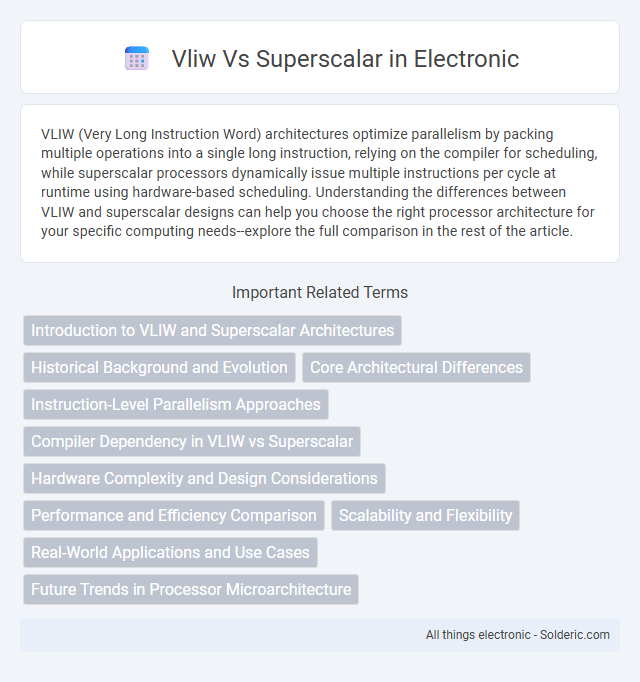VLIW (Very Long Instruction Word) architectures optimize parallelism by packing multiple operations into a single long instruction, relying on the compiler for scheduling, while superscalar processors dynamically issue multiple instructions per cycle at runtime using hardware-based scheduling. Understanding the differences between VLIW and superscalar designs can help you choose the right processor architecture for your specific computing needs--explore the full comparison in the rest of the article.
Comparison Table
| Feature | VLIW (Very Long Instruction Word) | Superscalar |
|---|---|---|
| Instruction Issue | Multiple operations issued in a single long instruction word | Multiple independent instructions issued per cycle dynamically |
| Hardware Complexity | Lower complexity, relies on compiler for scheduling | Higher complexity, uses dynamic hardware scheduling |
| Compiler Role | Critical, must schedule instructions statically | Less critical, hardware handles instruction scheduling |
| Parallelism | Exploits static instruction-level parallelism | Exploits dynamic instruction-level parallelism |
| Performance Dependency | Depends on compiler's ability to find parallelism | Depends on hardware's ability to detect parallelism dynamically |
| Code Size | Generally larger due to NOPs filling unused slots | More compact, no filled NOP slots |
| Examples | Itanium, TI TMS320C6000 | Intel Pentium Pro, AMD Athlon |
Introduction to VLIW and Superscalar Architectures
VLIW (Very Long Instruction Word) architectures rely on the compiler to identify and pack independent instructions into long instruction words for parallel execution, minimizing hardware complexity. Superscalar architectures dynamically extract instruction-level parallelism at runtime through complex hardware mechanisms such as out-of-order execution and speculative execution. Both approaches aim to enhance instruction throughput but differ in the balance between compiler dependency and hardware sophistication.
Historical Background and Evolution
VLIW (Very Long Instruction Word) architecture emerged in the 1980s as a solution to exploit instruction-level parallelism by encoding multiple operations into a single long instruction word, inspired by compiler advancements. Superscalar processors, developed in the late 1980s and early 1990s, dynamically issue multiple instructions per cycle using hardware-based instruction scheduling and out-of-order execution, aiming for higher performance without compiler dependency. Over time, the evolution of these architectures led to hybrid designs combining static compiler scheduling principles of VLIW with dynamic hardware techniques from superscalar models to optimize parallelism and efficiency.
Core Architectural Differences
VLIW (Very Long Instruction Word) architecture relies on the compiler to identify and pack independent instructions into a single long instruction word, enabling multiple operations to execute in parallel without complex hardware scheduling. Superscalar processors use dynamic hardware scheduling with multiple execution units to issue several instructions per cycle, relying on runtime instruction-level parallelism and out-of-order execution. The core architectural difference lies in VLIW's static scheduling approach versus the dynamic and hardware-driven instruction dispatching in superscalar designs.
Instruction-Level Parallelism Approaches
VLIW (Very Long Instruction Word) architecture exploits instruction-level parallelism (ILP) by statically scheduling multiple operations into a single long instruction word, relying on the compiler to identify and organize parallelism at compile-time. In contrast, superscalar processors dynamically issue multiple independent instructions per clock cycle using hardware-based out-of-order execution and dependency checking, maximizing ILP at runtime. Your choice between VLIW and superscalar depends on whether you prefer compiler-driven parallelism extraction or hardware-managed dynamic scheduling.
Compiler Dependency in VLIW vs Superscalar
VLIW architecture relies heavily on compiler technology to explicitly schedule instructions and expose parallelism at compile-time, reducing hardware complexity but increasing compiler dependency. Superscalar processors perform dynamic instruction scheduling and dependency checking at runtime, allowing more flexibility but requiring complex hardware mechanisms. Efficient compiler design is critical for VLIW performance, whereas superscalar systems depend more on sophisticated hardware to extract instruction-level parallelism.
Hardware Complexity and Design Considerations
VLIW architectures reduce hardware complexity by shifting instruction scheduling from runtime to the compiler, enabling simpler and less power-hungry processor designs compared to superscalar processors, which require complex dynamic scheduling, hazard detection, and out-of-order execution hardware. Superscalar designs incorporate advanced mechanisms like register renaming and branch prediction to maximize instruction-level parallelism, increasing overall design complexity and silicon area. Your choice between VLIW and superscalar impacts not only processor performance but also heat dissipation, manufacturing cost, and software toolchain requirements.
Performance and Efficiency Comparison
VLIW architecture achieves higher instruction-level parallelism by explicitly encoding multiple operations in a single wide instruction, leading to more predictable performance and reduced hardware complexity compared to superscalar designs. Superscalar processors rely on dynamic scheduling and out-of-order execution to exploit parallelism, which improves instruction throughput but increases hardware complexity and power consumption. VLIW offers better energy efficiency due to simpler control logic, while superscalar provides superior performance under unpredictable workloads by adapting instruction execution dynamically.
Scalability and Flexibility
VLIW architectures achieve scalability by statically encoding multiple operations in a single wide instruction word, enabling parallel execution without complex hardware scheduling, but this limits flexibility when handling unpredictable instruction-level parallelism. Superscalar processors dynamically schedule instructions at runtime, allowing greater adaptability to varying workloads and dynamic instruction dependencies, enhancing flexibility across diverse applications. While VLIW designs scale with instruction width, superscalar architectures scale through more sophisticated hardware mechanisms, balancing performance gains against increased control complexity.
Real-World Applications and Use Cases
VLIW architectures excel in embedded systems and digital signal processing where predictable instruction scheduling boosts performance and power efficiency. Superscalar processors dominate general-purpose computing, including desktops and servers, by dynamically issuing multiple instructions per cycle to optimize performance under varied workloads. Your hardware choice depends on application-specific demands, prioritizing either efficient parallelism with VLIW or flexibility and dynamic instruction-level parallelism with superscalar designs.
Future Trends in Processor Microarchitecture
Future trends in processor microarchitecture emphasize enhanced instruction-level parallelism through hybrid models combining VLIW (Very Long Instruction Word) and superscalar techniques. Emerging designs leverage machine learning algorithms for dynamic scheduling, improving efficiency in both static VLIW bundles and dynamic superscalar dispatch. Energy efficiency and scalability remain critical, driving innovation in adaptive pipeline architectures that optimize performance across diverse workloads.
vliw vs superscalar Infographic

 solderic.com
solderic.com